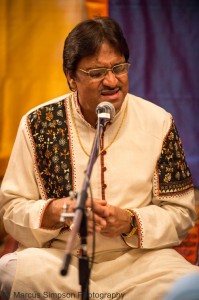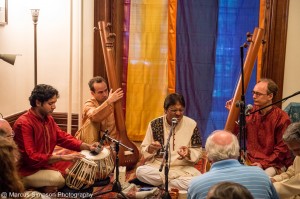Date: July 22, 2012
Venue: house concert in the Upper West Side
Next show: August 1, at 8pm. Details here.
Review by Dawoud Kringle and photos by Marcus Simpson
 Indian classical music is based essentially on vocal music. It is a widely held belief among the genre’s masters that without an understanding of vocal music, one cannot ever properly perform a raga. Arabic music, African, and some jazz (such as Dexter Gordon, who refused to play a song unless he knew the lyrics) all hold this to be true. So, when one is listening to a raga sung by a master, one is assured one is getting the real thing.
Indian classical music is based essentially on vocal music. It is a widely held belief among the genre’s masters that without an understanding of vocal music, one cannot ever properly perform a raga. Arabic music, African, and some jazz (such as Dexter Gordon, who refused to play a song unless he knew the lyrics) all hold this to be true. So, when one is listening to a raga sung by a master, one is assured one is getting the real thing.
On Sunday, July 22nd, 2012, an intimate concert of vocal music by raga master Ustad Mashkoor Ali Khan bore witness to this.
Ustad Mashkoor Ali Khan comes from a family of musical royalty. He is one of the few family inheritors of the great Kirana Gharana. His brother Ustad Mubarak Ali Khan is also a noted vocalist. Trained for over fifteen years by his father, noted sarangi player Ustad Shakoor Khan, he later studied as a scholar at the ITC Sangeet Research Academy. He has appeared on many recordings and prestigious stages. In 2004 he was awarded the Ustad Niaz Ahaed Khan and Ustad Faiyaz Ahmed Khan Memorial Awards.
Joining him was an ensemble of fine musicians. On tabla was Nitin Mitta; one of the finest and most sought after tabla players on the scene. A student of Pandit G. Satanarayana and Pandit Arvind Mulgaonkar, he has performed with Pandit Jasraj, Pandits Rajan and Sajan Mishra, Pandit Vishwa Mohan Bhatt, Ustad Nishat Khan, Ustad Shahid Parvez and Pandit Nayan Ghosh.
On harmonium was Madhi Vora; a man whose extensive experience as an accompanist has led him to share the stage with luminaries such as Khan Saheb Abdul Karim Khan, Ustad Amir Khan, Ustad Bade Ghulam Ali Khan, Ustad Salamat Ali and Nazakat Ali Khan, Ustad Vilayat Khan, Pandit. Nikhil Benerjee, Pandit. Pannalal Ghosh, Pandit. D.V. Paluskar and many others.
On vocals and tambura were Michael Harrison and Aaron Shragge. Michael Harrison, a former student and associate of Pandit Pran Nath, Terry Riley, and LaMonte Young, is, in addition to being a fine vocalist, is also a master pianist and composer of groundbreaking works that push the envelope of musical possibilities on the instrument, including compositions for justly intoned piano and an extensively modified piano capable of producing 24 notes per octave. Aaron Shragge studied the ancient musical traditions of North India and Japan. Shragge earned a BFA in Jazz and Contemporary Music from New School University and is currently perusing a Master’s in Music therapy at New York University. He has studied improvisation with Kenny Werner, and is currently studying trumpet with Laurie Frink, shakuhachi with Grand Master’s Ronnie Nyogetsu Seldin and Yodo Kurahashi II. Shragge has performed with Daniel Carter, Akim Funk Buddha, and Medeski, Martin and Wood’s Billy Martin, and performed at many prestigious venues. Both men study North Indian vocals with Ustad Mashkoor Ali Khan.
The concert was produced by HarmoNYom; an organization led by Veronique Lerebours, one of the leading producers of classical Indian music concerts in New York. This concert was held at a private residence; a brownstone on Manhattan’s Upper West Side. The apartment was cramped; owing to the many people who came to hear the Ustad sing.
Harisson and Shragge both played tambura, but they also used an electronic shruti box. The colorful and thick as a jungle, C# simultaneously augmented and challenged the vocals with an almost excessive lushness and density of harmonics. In the hands of a lesser vocalist, would have overwhelmed the music. or at least turned the performance into a collage of gimmickry. Not so with Ustad Khan.
Ustad Khan began with rag Puriya Danashri. The alap with which he began the raga was slow, carefully and delicately unveiling the mood of the piece note by note. He seemed to be holding up each note of the raga like a jewel, commenting on it, and inviting the audience to admire its beauty before moving on to the next note. Melodies unfolded as the notes were allowed to dance on their own within the raga. Vora’s harmonium and Harrison’s vocals floated around Ustad Khan’s vocals and occasionally syncing with him.
The essence of the raga and the composition it gave birth to dominated the room. I remember the Ustad’s use of the komal re (which a westerner would interpret as a flat 2nd) stood out in my mind as particularly powerful and dramatic. The effect was inescapable. Many people in the audience were familiar with the composition, and many sang (almost) silently with him. Mitta’s tabla came in and provided a solid backbone for the piece in an eleven beat cycle,. The complexity of the tal increased imperceptibly, and always brought both service and its own beauty to the music. The overall complexity increased, producing a display of musical pyrotechnics, eventually creating with the backing vocals an almost Qawalli effect. It ended dramatically on a drone.
The next piece was a bandish, a composition called “Chayanat.” Again, the audience was familiar with the piece, and very quietly sang along on certain phrases. This had a brighter mood than the more serious Puriya Danashri. In this, Ustad Khan was quicker to propel the music toward an environment where a display of virtuosity was called for. There were more opportunities for Harisson to show his vocal prowess: and although he is a skilled singer, and possesses more than sufficient sensitivity to the music, his natural vocal tone was a very noticeable contrast to one born into that culture. He added an interesting element. The piece ended exactly as it began.
A short intermission was voted on (yes; Veronique took a vote. Ustad Khan left it to the audience’s discretion. He said he could continue for another hour and a half).
When the musicians returned, and everyone got comfortable in the limited space, they began with a piece in teental. Ustad Khan did almost all the singing in this, although Harisson made some contribution. There were a few exchanges, but, as is the case in this music, the Ustad led and directed the course of the music and its improvisations. The piece increased in complexity and speed, and stopped with a startling abruptness.
Ustad Khan spoke briefly (and very quietly, in his thick accent which I must confess I had difficulty understanding) about a deceased musician. Then he began a somber piece; one filled with a noticeable sadness, that increased in its intensity. Smooth flowing rhythms, out of which gats would soar and land seamlessly on the sum. Serpentine notes and meends glided on beautiful currents.
Next they played a piece based on rag Malkauns. This, like some of the earlier pieces, was not sung in sargam; and I would have liked to have known the lyrics of this piece. It seemed like I was missing something important. The gats were one surprise after another.
After a final song, the concert ended.
Ustad Khan proved effortlessly himself to be a master of his craft. Every moment of the performance was filled with beauty and meaning. And, for me, I came to realize that this setting, an intimate gathering where there is little distance or barrier between musicians and audience, is one of the best ways to experience this music. There was an intimacy and immediacy in the way the music was presented that hearkens to the “glory days” of the ancient Indian civilization from which this music came. The demonstrative mannerisms of the Indian audience, executed in a way unique to this culture and mindset, were as important to the music as the musicians themselves. This spoke eloquently of the importance of preserving and building upon these traditions, and the importance of live music.


